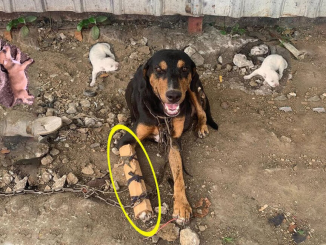Dogs’ brains are sensitive to the familiar high-pitched “cute” voice tone that adult humans, especially women, use to talk to babies, according to a new study.
The research, published recently in the journal Communications Biology, found “exciting similarities” between infant and dog brains during the processing of speech with such a high-pitched tone feature.
Humans tend to speak with a specific speech style characterised by exaggerated prosody, or patterns of stress and intonation in a language, when communicating with individuals having limited language competence.
Such speech has previously been found to be very important for the healthy cognitive, social and language development of children, who are also tuned to such a high-pitched voice.
But researchers, including those from the Eötvös Loránd University in Hungary, hoped to assess whether dog brains are also sensitive to this way of communication.
In the study, conscious family dogs were made to listen to dog, infant and adult-directed speech recorded from 12 women and men in real-life interactions.
As the dogs listened, their brain activities were measured using a functional magnetic resonance imaging (fMRI) scan.
The study found the sound-processing regions of the dogs’ brains responded more to dog- and infant-directed than adult-directed speech.
This marked the first neurological evidence that dog brains are tuned to speech directed specifically at them.
“Studying how dog brains process dog-directed speech is exciting, because it can help us understand how exaggerated prosody contributes to efficient speech processing in a nonhuman species skilled at relying on different speech cues,” explained Anna Gergely, co-first author of the study.
Scientists also found dog- and infant-directed speech sensitivity of dog brains was more pronounced when the speakers were women, and was affected by voice pitch and its variation.
These findings suggest the way we speak to dogs matters, and that their brain is specifically sensitive to the higher-pitched voice tone typical to the female voice.
“Remarkably, the voice tone patterns characterizing women’s dog-directed speech are not typically used in dog-dog communication – our results may thus serve evidence for a neural preference that dogs developed during their domestication,” said Anna Gábor, co-first author of the study.
“Dog brains’ increased sensitivity to dog-directed speech spoken by women specifically may be due to the fact that women more often speak to dogs with exaggerated prosody than men,” Dr Gabor said.

“Celebrating Our Senior Canine Companion: A Heartwarming Family Gathering for the Old Dog’s Birthday”

Dr. Bhavesh’s remarkable journey to establish RRSAINDIA finds its roots in his lifelong affection for animal welfare. His compassion for creatures, kindled from an early age, developed into a fervent commitment that led him to become a veterinarian.

The central focus of his career has been aiding homeless animals within his community. Recognizing the challenges these animals faced in terms of medical care, food, and shelter, Dr. Bhavesh remained steadfast in his mission to mend their physical wounds and provide them the care they deserved.

One pivotal encounter with a patient, Stuffy, unveiled the emotional dimension of animal suffering, profoundly impacting Dr. Bhavesh. Stuffy transcended being a mere patient, becoming a catalyst for a deeper, empathetic connection between him and the animals under his care.

This emotional awakening catalyzed the birth of RRSAINDIA. Dr. Bhavesh realized that holistic healing encompassed not only physical recovery but also addressing the emotional scars of these animals. The charity he founded aimed to merge physical well-being with emotional healing, promising comprehensive care for every creature in need.

RRSAINDIA swiftly became a beacon of hope for homeless animals, offering medical attention, nourishment, shelter, and most importantly, emotional succor. Dr. Bhavesh’s unwavering dedication drew others in the community to rally behind his cause, transforming countless lives in the process.

His journey encapsulates the power of empathy, dedication, and unwavering passion. The lessons learned from Stuffy ignited a revolution in Dr. Bhavesh’s approach, enriching his mission with emotional support alongside physical aid. RRSAINDIA’s inception stands as a testament to his boundless commitment to the welfare of homeless animals and a beacon of inspiration for others to follow suit.



Leave a Reply